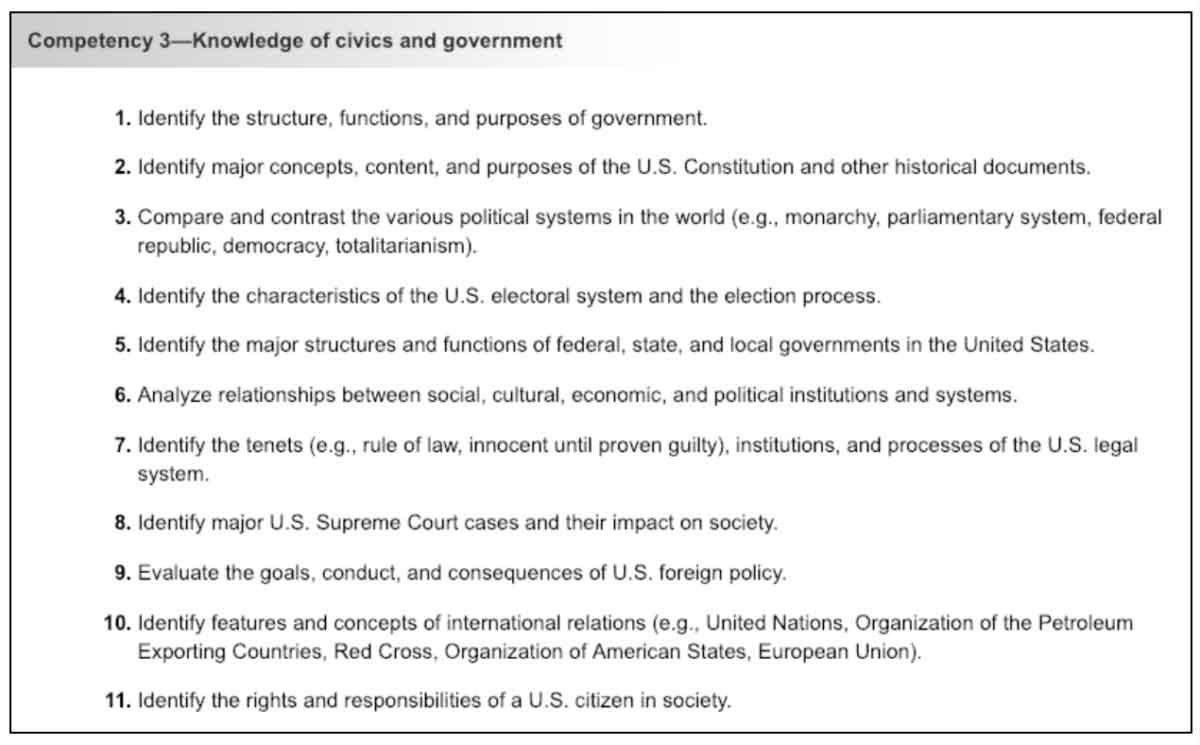FTCE Middle Grades Social Science 5-9 Competency 3: Civics and Government

The civics and government competency includes about 30 multiple-choice questions which makes up about 25% of the entire exam.
These questions test your knowledge of concepts and events related to the U.S. Government and the rights and duties of American citizens.
The following concepts may pop up on the test.
Democracy
Democracy is a system of government where citizens exercise their power through voting. There are two main types of democracies:
Direct democracy
(less common) in which citizens form a governing body and vote directly on every issue
Indirect democracy
(more common) where citizens elect representatives who vote on issues for them
Direct Democracy Pros and Cons
Pros:
- A vote actually counts
- Total transparency
- Government accountability
- Creates a happy society
- People control the quality of their life
Cons:
- It can be difficult to make a final decision
- People don’t always participate
- Can encourage more segregation
- Potential for manipulation is high
- Can be unstable
- Difficult to regulate
- Does not typically work in a large country
Representative (Indirect) Democracy Pros and Cons
Pros:
- Still gives some power to citizens
- System of checks and balances is in place
- All citizens are given the opportunity to participate
- Government can work quickly
- Citizens are encouraged to participate
- Allows for different levels of government
Cons:
- Polarization between those who have opposing views
- Possibility of a super majority forming
- Citizens must be able to trust their representatives
- Voice of the people typically ends with a general election
- Focuses on the majority
Code of Hammurabi
Discovered in 1901 by Jean-Vincent Scheil, the Code of Hammurabi (1754 BCE) is a Babylonian code of law of Ancient Mesopotamia written on a 7ft tall piece of rock. The Code of Hammurabi, along with the Rosetta Stone, is one of the most significant artifacts of the ancient world, because it details what culture, life, and laws were like in Babylonia.
Written by King Hammurabi during a time of prosperity in Babylonia, the Code of Hammurabi lists almost 300 laws written in an if/then or conditional format. The laws make it clear that justice was top priority in Babylonia during this time period.
Today, historians study and discuss Hammurabi’s Code to gain insight into an important history of justice, law, and even the Bible.
Notable Supreme Court Cases
Here are some Supreme Court cases you should definitely know.
Marbury v. Madison (1803)
It confirmed the legal principle of judicial review (the ability of the U.S. Supreme Court to limit the power of congress by declaring legislation unconstitutional).
This case was brought about when President Thomas Jefferson, through his secretary of state, James Madison, prevented William
Marbury from taking office as justice of the peace. John Marshall, the head Supreme Court justice, argued that acts of congress that conflict with the Constitution are not law and are non-binding to the courts.
Brown v. Board of Education (1954)
It declared segregation in public schools violated the 14th amendment and was, therefore, unconstitutional.
This case was brought about when Oliver Brown filed a class-action suit against the Topeka, Kansas Board of Education in 1951 after his daughter, Linda, was denied entrance into an all-white elementary school. Brown claimed that all-black schools were not equal to all-white schools, which violated the 14th amendment. In his decision, Chief Justice Earl Warren wrote that, “in the field of public education the doctrine of ‘separate but equal’ has no place,” as segregated schools are “inherently unequal.”
Gideon v. Wainwright (1963)
It ruled unanimously that under the 6th amendment, states must provide attorneys to criminal defendants if they cannot afford one themselves.
This case was brought about when Clarence Earl Gideon was charged with a felony crime in Florida. Gideon could not afford an attorney to represent him, and in open court, he asked the presiding judge to appoint an attorney to him. The judge denied his request, because Florida law only allowed appointed attorneys for poor defendants who were charged with a capital offense. Gideon represented himself in that case, but was found guilty and sentenced to time in prison. While in prison, Gideon filed a petition for writ of habeas corpus in the Florida Supreme Court, and then later filed a petition in the U.S. Supreme Court. The U.S. Supreme Court ruled that guarantee of counsel is a fundamental right in a fair trial.
Obergefell v. Hodges (2015)
It ruled that same-sex couples have a guaranteed right to marry by both the Due Process Clause and the Equal Protection Clause of the 14th amendment.
This case made its way to the U.S. Supreme Court when district court rulings in Michigan, Ohio, Kentucky, and Tennessee were appealed to multiple circuit courts. Baker v. Nelson was the case that set the precedent that a ban on same-sex marriage was constitutional; therefore, Obergefell v. Hodges overturned Baker v. Nelson and required all states and U.S. territories to issue marriage licenses to same-sex couples and to recognize same-sex marriages validly performed in other jurisdictions.
And that is some information about Competency 3: Civics and Government on the FTCE Middle Grades Social Science 5-9 exam.
